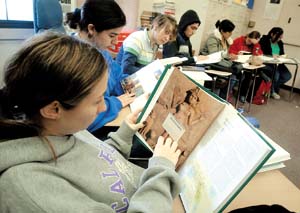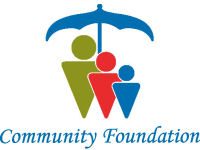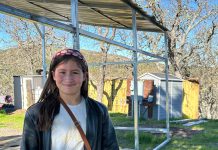
In response to a dramatic ‘F’ rate and the loss of more than 100
students to continuation schools last year, San Benito High School
is considering a radical new program for students who can not
thrive in a conventional high school setting.
In response to a dramatic ‘F’ rate and the loss of more than 100 students to continuation schools last year, San Benito High School is considering a radical new program for students who can not thrive in a conventional high school setting.
“I think a program like this has a lot to offer a variety of students,” said Karen Schroder, Director of Alternative Education and Special Education at SBHS. “It will benefit students as well as the district.”
The program, called “Pathways,” was presented at last week’s board meeting and could become a reality by next fall. Proponents feel it will be invaluable not only to students traditionally labeled “at-risk,” but to some of the school’s brightest students who may be performing poorly due to sheer boredom.
Pathways will establish a small “School within a school” on the SBHS campus which will serve a maximum of about 400 students. Students will most likely only attend class for a half day, like students at San Andreas Continuation High School, and will attend small classes taught by teachers who volunteer to participate in the program. Intensive tutorial sessions called “learning labs” and personal advisers or caseworkers will be available to all students, who will be expected to take advantage of them.
“We’re going for a two-prong approach,” Schroder said. “One part of the program is designed for students who need a lighter academic course load and are looking for a vocational path, and the other one is for students who think they want to go to college but maybe are still hesitant about their skills, so we give them an opportunity to take some college classes online.”
The first option focuses on basic skills – grouping students together in a learning lab to supplement their core classes and exposing them to different Regional Occupation Program courses. These classes teach vocational skills ranging from welding to the culinary arts, and entitle the student to a certificate of completion stating that they are qualified for an entry level position in the field.
The second option offers students the opportunity to complete up to 28 college credits – about a year’s worth of work – over the course of their high school career by taking courses online with the guidance of a high school teacher. Students will receive credit for high school classes simultaneously, offering the industrious student a shot at early graduation and an opportunity SBHS believes will entice many of their brightest students, as well as a number of those already enrolled in an independent study program.
“Basically these students will already have a transcript from a California community college when they’re ready to graduate,” Schroder said. “And that’s great for these students because those credits have to be honored, while some colleges don’t accept AP scores as a substitute for class credit.”
Both options make use of independent study courses with teacher guidance, especially for fine arts and physical education credits. In addition, they more than satisfy SBHS’ graduation requirements and, with an extra class added to the school day or a summer school class one year, will make graduates eligible for admission to the California State University and University of California systems.
Though students will have separate classes and morning breaks from the rest of the high school students, they will share a lunchtime. Pathways students can also participate in all school clubs, athletics and other activities provided they keep their GPA at a ‘C’ average – opportunities they would not be afforded at a continuation school.
“Really, these students are getting the best of a small school setting and of a larger school,” said Superintendent Jean Burns Slater. “They can get the individual attention they need and still have an active role in student life, because the activities are really a big part of this school.”
Parents whose children have been through independent study programs or continuation schools say Pathways strikes a balance that is more beneficial for students than either program could be alone.
“Once it all started coming together, I thought, ‘This is perfect,'” said Ardyss Golden, a member of the Alternative Ed Task Force who has taken in numerous foster children from social services and probation. “If we’d have had this earlier, my children wouldn’t have been so lonely – they would have had more chances to succeed.”
But best of all, says Schroder, the program will end up paying for itself. Each year SBHS loses state funds every time a student goes to a continuation school, community college or drops out altogether. And after the student turns 16, it is illegal for the district to prevent a student from transferring to another campus of his or her choice. If the program is adopted and attracts enough students, not only will it be self-sufficient, but could actually make the school money.
State officials who have been working with SBHS to fine-tune the program are enthusiastic about its potential, Schroder said. While some schools offer programs for students looking into college credit or for those who might slip between the cracks, few, if any, have worked to integrate them.
“It’s a real hybrid of programs,” Schroder said. “But you can do so much more with a small school setting that will work for many students. It’s hard to move a large institution like San Benito.”
So far, teachers and the district alike have responded favorably to the school-within-a-school concept, but the matter will not be voted on until March 22. Between then and now, a priority of the Alternative Ed Task Force is community outreach, and ensuring that parents and educators are aware of the program and determining who would be interested in it.
Should the program be approved, it could start next fall, with a small group of ninth-and tenth-graders.
“A program like this has the potential to save a lot of students,” said Chuck Schallhorn, SBHS Teacher’s Union president. “We know we can’t save everyone, but we can do our damnedest to make sure we catch everybody we can.”
SBHS will be holding an informational meeting for parents and students interested in the program on March 21 at the main campus in room 172. A session for those interested in the vocational line of study will be held at 6:30pm and another for the early-college option will be held at 7:30pm. For more information call 637-5831 ext. 449.
Danielle Smith covers education for the Free Lance. Reach her at 637-5566, ext. 336 or [email protected]









